
The Trent Navigation Company existed from 1783 to 1940. It was responsible for control of navigation on the River Trent in England.

The Trent Navigation Company existed from 1783 to 1940. It was responsible for control of navigation on the River Trent in England.


| Trent Navigation Act 1783 | |
|---|---|
| Act of Parliament | |
 | |
| Long title | An Act for empowering Persons navigating Vessels upon the River Trent, between a Place called Wilden Ferry, in the Counties of Derby and Leicester, or one of them, and the Town of Burton upon Trent, in the County of Stafford, to hale the same with Horses. |
| Citation | 23 Geo. 3. c. 41 |
| Dates | |
| Royal assent | 17 April 1783 |
The Trent Navigation Company was established by Trent Navigation Act 1783 (23 Geo. 3. c. 41) 'An Act for improving the Navigation of the River Trent'. [1] It was responsible for improving and maintaining the navigation on the river between Wilden Ferry (near Cavendish Bridge) and Gainsborough (with the exception of Averham to South Muskham), and junctions with the various other canals. The first business tackled by the company was the building of towpaths.
Some of the canals opening in the 1790s offered routes for traffic by-passing large sections of the River Trent. By 1796 the Derby Canal connected directly to the Erewash Canal at Sandiacre and the River Trent at Swarkestone. The Nottingham Canal ran from the Erewash Canal junction at Langley Mill, which itself linked to the Cromford Canal, down to the River Trent near Trent Bridge in Nottingham. Coal from Derbyshire could be transported to Nottingham and Derby without using the river.

| River Trent Navigation Act 1794 | |
|---|---|
| Act of Parliament | |
 | |
| Long title | An act to alter and amend an act of the twenty-third year of his present Majesty, for improving the navigation of the river Trent; and for making and maintaining a navigable canal, from the said river, in the parish of Beeston, to join the Nottingham canal, in the parish of Lenton, in the county of Nottingham, and also certain cuts on the side of the said river. |
| Citation | 34 Geo. 3. c. 95 |
| Dates | |
| Royal assent | 9 May 1794 |
The competition prompted the company to implement canals cuts of their own. The Sawley cut, the Cranfleet cut and the Beeston canal provided easier navigation avoiding difficult and shallow sections of the river. [2]
In a minor hiccup in its history, an Act of Parliament of 1887[ which? ] caused the company to be taken over by the Trent (Burton-upon-Trent and Humber) Navigation Company. The Trent Navigation Act 1892 restored the original company name.

In 1906 the Trent Navigation Company obtained an Act of Parliament[ which? ] authorising improvements upstream of Newark. However, only one lock at Cromwell was constructed before the outbreak of the First World War. [3] By the Nottingham Corporation (Trent Navigation Transfer) Act 1915, the river from Averham to Nottingham was put under the control of Nottingham Corporation. They implemented improvements to a value of £450,000 (equivalent to £28,580,000 in 2021), [4] which included a new locks and a cut at Holme Lock. The works completed by 1927 enabled larger river boats to sail up to Nottingham from Hull and the continent. [5]
In 1937, the bulk of the Nottingham Canal was closed with the exception of the stretch through Nottingham, from Trent Bridge to the junction with the Beeston Canal at Lenton. This was taken over by the Trent Navigation Company. [6]
The Trent Navigation Company ceased to exist in 1940, when it was taken over by the Trent River Catchment Board. [7] The catchment board was replaced by the Trent River Board in 1951 [8] and by the Trent River Authority in 1965. [9]
Annual tonnage carried for the years 1913 to 1926 inclusive 29,062 tons. [10]
The annual tonnage carried increased more than eight-fold following the Nottingham Corporation assumption of control of part of the Trent Navigation.
In the late 1930s, the powerful motor vessels and dumb barges owned by the company had a total carrying capacity of 4,500 tons. [11] Each day, vessels were in attendance at each of the Hull docks and consignments of five tons and upwards were collected direct overside from steamers. Under an ancient charter, the port of Hull is free to river and canal craft. No wharfage or landing charges were incurred when cargo was directly discharged into the company's boats.
A train of the company's barges could reach Gainsborough within five hours from Hull, and Newark-on-Trent within twelve hours. The journey from Hull to Nottingham took eighteen hours.
A typical train consisted of a mechanically propelled barge carrying 60 tons, towing three dumb barges each of which had 120 tons of goods. The largest trains of barges could carry 600 tons of cargo.

The Aire and Calder Navigation is the canalised section of the Rivers Aire and Calder in West Yorkshire, England. The first improvements to the rivers above Knottingley were completed in 1704 when the Aire was made navigable to Leeds and the Calder to Wakefield, by the construction of 16 locks. Lock sizes were increased several times, as was the depth of water, to enable larger boats to use the system. The Aire below Haddlesey was bypassed by the opening of the Selby Canal in 1778. A canal from Knottingley to the new docks and new town at Goole provided a much shorter route to the River Ouse from 1826. The New Junction Canal was constructed in 1905, to link the system to the River Don Navigation, by then part of the Sheffield and South Yorkshire Navigation.
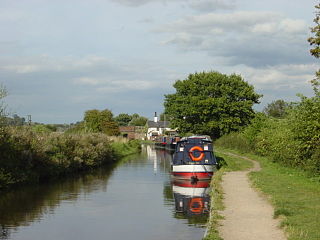
The Trent and Mersey Canal is a 93+1⁄2-mile (150 km) canal in Derbyshire, Staffordshire and Cheshire in north-central England. It is a "narrow canal" for the vast majority of its length, but at the extremities to the east of Burton upon Trent and north of Middlewich, it is a wide canal.
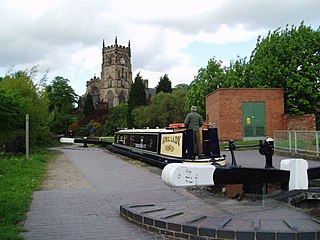
The Staffordshire and Worcestershire Canal is a navigable narrow canal in Staffordshire and Worcestershire in the English Midlands. It is 46 miles (74 km) long, linking the River Severn at Stourport in Worcestershire with the Trent and Mersey Canal at Haywood Junction by Great Haywood.
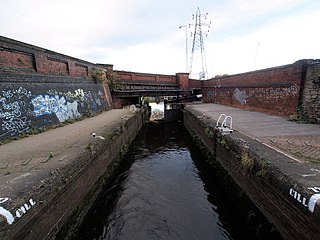
The Sheffield and South Yorkshire Navigation (S&SY) is a system of navigable inland waterways in South Yorkshire and Lincolnshire, England.

The Trent is the third-longest river in the United Kingdom. Its source is in Staffordshire, on the southern edge of Biddulph Moor. It flows through and drains the North Midlands into the Humber Estuary. The river is known for dramatic flooding after storms and spring snowmelt, which in the past often caused the river to change course.

The River Arun is a river in the English county of West Sussex. At 37 miles (60 km) long, it is the longest river entirely in Sussex and one of the longest starting in Sussex after the River Medway, River Wey and River Mole. From the series of small streams that form its source in the area of St Leonard's Forest in the Weald, the Arun flows westwards through Horsham to Nowhurst where it is joined by the North River. Turning to the south, it is joined by its main tributary, the western River Rother, and continues through a gap in the South Downs to Arundel to join the English Channel at Littlehampton. It is one of the faster flowing rivers in England, and is tidal as far inland as Pallingham Quay, 25.5 miles (41.0 km) upstream from the sea at Littlehampton. The Arun gives its name to the Arun local government district of West Sussex.

The River Weaver is a river, navigable in its lower reaches, running in a curving route anti-clockwise across west Cheshire, northern England. Improvements to the river to make it navigable were authorised in 1720 and the work, which included eleven locks, was completed in 1732. An unusual clause in the enabling Act of Parliament stipulated that profits should be given to the County of Cheshire for the improvement of roads and bridges, but the navigation was not initially profitable, and it was 1775 before the first payments were made. Trade continued to rise, and by 1845, over £500,000 had been given to the county.
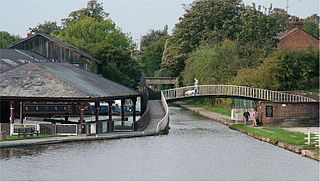
The Chester Canal was an English canal linking the south Cheshire town of Nantwich with the River Dee at Chester. It was intended to link Chester to Middlewich, with a branch to Nantwich, but the Trent and Mersey Canal were unco-operative about a junction at Middlewich, and so the route to Nantwich was opened in 1779. There were also difficulties negotiating with the River Dee Company, and with no possibility of through traffic, the canal was uneconomic. Part of it was closed in 1787, when Beeston staircase locks collapsed, and there was no money to fund repairs. When the Ellesmere Canal was proposed in 1790, the company saw it as a ray of hope, and somehow managed to keep the struggling canal open. The Ellesmere Canal provided a link to the River Mersey at Ellesmere Port from 1797, and the fortunes of the Chester Canal began to improve.

The Lee Navigation is a canalised river incorporating the River Lea. It flows from Hertford Castle Weir to the River Thames at Bow Creek; its first lock is Hertford Lock and its last Bow Locks.
The Grand Junction Canal is a canal in England from Braunston in Northamptonshire to the River Thames at Brentford, with a number of branches. The mainline was built between 1793 and 1805, to improve the route from the Midlands to London, by-passing the upper reaches of the River Thames near Oxford, thus shortening the journey.

The Cromford Canal ran 14.5 miles from Cromford to the Erewash Canal in Derbyshire, England with a branch to Pinxton. Built by William Jessop with the assistance of Benjamin Outram, its alignment included four tunnels and 14 locks.

The Derby Canal ran 14 miles (23 km) from the Trent and Mersey Canal at Swarkestone to Derby and Little Eaton, and to the Erewash Canal at Sandiacre, in Derbyshire, England. The canal was authorised by an Act of Parliament in 1793 and was fully completed in 1796. It featured a level crossing of the River Derwent in the centre of Derby. An early tramroad, known as the Little Eaton Gangway, linked Little Eaton to coal mines at Denby. The canal's main cargo was coal, and it was relatively successful until the arrival of the railways in 1840. It gradually declined, with the gangway closing in 1908 and the Little Eaton Branch in 1935. Early attempts at restoration were thwarted by the closure of the whole canal in 1964. Since 1994, there has been an active campaign for restoration spearheaded by the Derby and Sandiacre Canal Trust and Society. Loss of the Derwent crossing due to development has resulted in an innovative engineering solution called the Derby Arm being proposed, as a way of transferring boats across the river.

The Erewash Canal is a broad canal in Derbyshire, England. It runs just under 12 miles (19 km) and has 14 locks. The first lock at Langley Bridge is part of the Cromford Canal.
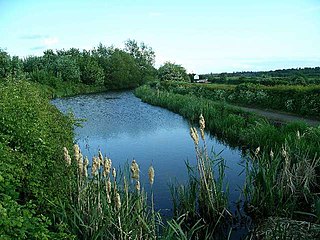
The Nottingham Canal is a canal in the English counties of Nottinghamshire and Derbyshire. As built, it comprised a 14.7-mile (23.7 km) long main line between the River Trent just downstream of Trent Bridge in Nottingham and Langley Mill in Derbyshire. At the same time as the main line of the canal was built by its proprietors, the separate Trent Navigation Company built the Beeston Cut, from the main line at Lenton in Nottingham to rejoin the River Trent upstream of Nottingham, thus bypassing the difficult section of navigation through Trent Bridge. The section of the main line between Trent Bridge and Lenton, together with the Beeston Cut, is still in use, forming part of the navigation of the River Trent and sometimes referred to as the Nottingham & Beeston Canal. The remainder of the main line of the canal beyond Lenton has been abandoned and partially filled.
The Derbyshire and Staffordshire extension of the Great Northern Railway was an English railway network built by the GNR to get access to coal resources in the area to the north and west of Nottingham. The Midland Railway had obstructed the GNR in its attempts to secure a share of the lucrative business of transporting coal from the area, and in frustration the GNR built the line. The line was forked: it reached Pinxton in 1875 and a junction with the North Staffordshire Railway at Egginton, approaching Burton on Trent in 1878. The line cut through Derby, resulting in considerable demolition of housing there.
The Erewash Valley Line is a railway line in England, running from Long Eaton, located between Nottingham and Derby, and Clay Cross, near Chesterfield. The southern part was opened by the Midland Railway in 1847 as far as Codnor Park, where it connected to established ironworks, and soon after, a line to Pinxton and Mansfield.

The Stainforth and Keadby Canal is a navigable canal in South Yorkshire and Lincolnshire, England. It connects the River Don Navigation at Bramwith to the River Trent at Keadby, by way of Stainforth, Thorne and Ealand, near Crowle. It opened in 1802, passed into the control of the River Don Navigation in 1849, and within a year was controlled by the first of several railway companies. It became part of the Sheffield and South Yorkshire Navigation, an attempt to remove several canals from railway control, in 1895. There were plans to upgrade it to take larger barges and to improve the port facilities at Keadby, but the completion of the New Junction Canal in 1905 made this unnecessary, as Goole could easily be reached and was already a thriving port.

Trent railway station was situated near Long Eaton in Derbyshire at the junction of the Midland Railway line from London to Derby and Nottingham. It was unusual in that it did not serve any community, being simply an interchange.
The Trent River Authority was one of 27 river authorities created by the Water Resources Act 1963. It took over the powers of the existing Trent River Board and was given additional duties to monitor water quality and protect water resources.
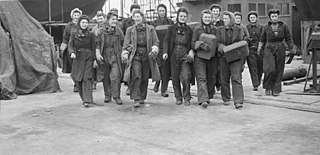
Henry Scarr Ltd. was an English shipbuilding company based in the East Riding of Yorkshire at Hessle on the Humber. Henry Scarr took over an existing shipyard in 1897, and continued to build ships there until 1932, when the site was bought by Richard Dunston Ltd. Dunstons operated the shipyard until 1974, and after a series of takeovers, shipbuilding ceased in 1994.